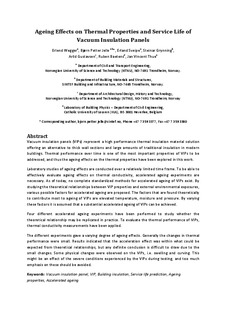| dc.contributor.author | Wegger, Erlend | |
| dc.contributor.author | Jelle, Bjørn Petter | |
| dc.contributor.author | Sveipe, Erland | |
| dc.contributor.author | Grynning, Steinar | |
| dc.contributor.author | Gustavsen, Arild | |
| dc.contributor.author | Baetens, Ruben | |
| dc.contributor.author | Thue, Jan Vincent | |
| dc.date.accessioned | 2017-03-30T07:27:53Z | |
| dc.date.available | 2017-03-30T07:27:53Z | |
| dc.date.created | 2011-01-31T19:33:48Z | |
| dc.date.issued | 2011 | |
| dc.identifier.citation | Journal of Building Physics. 2011, 35 (2), 128-167. | nb_NO |
| dc.identifier.issn | 1744-2591 | |
| dc.identifier.uri | http://hdl.handle.net/11250/2436284 | |
| dc.description.abstract | Vacuum insulation panels (VIPs) represent a high-performance thermal insulation material solution offering an alternative to thick wall sections and large amounts of traditional insulation in modern buildings. Thermal performance over time is one of the most important properties of VIPs to be addressed, and thus the aging effects on the thermal properties have been explored in this article. Laboratory studies of aging effects are conducted over a relatively limited time frame. To be able to effectively evaluate aging effects on thermal conductivity, accelerated aging experiments are necessary. As of today, no complete standardized methods for accelerated aging of VIPs exist. By studying the theoretical relationships between VIP properties and external environmental exposures, various possible factors for accelerated aging are proposed. The factors that are found theoretically to contribute most to aging of VIPs are elevated temperature, moisture, and pressure. By varying these factors, it is assumed that a substantial accelerated aging of VIPs can be achieved. Four different accelerated aging experiments have been performed to study whether the theoretical relationship may be replicated in practice. To evaluate the thermal performance of VIPs, thermal conductivity measurements have been applied. The different experiments gave a varying degree of aging effects. Generally, the changes in thermal performance were small. Results indicated that the acceleration effect was within what could be expected from theoretical relationships, but any definite conclusion is difficult to draw due to the small changes. Some physical changes were observed on the VIPs, i.e., swelling and curving. This might be an effect of the severe conditions experienced by the VIPs during testing, and too much emphasis on these should be avoided. | nb_NO |
| dc.language.iso | eng | nb_NO |
| dc.publisher | SAGE Publications | nb_NO |
| dc.title | Aging effects on thermal properties and service life of vacuum insulation panels | nb_NO |
| dc.type | Journal article | nb_NO |
| dc.type | Peer reviewed | nb_NO |
| dc.source.pagenumber | 128-167 | nb_NO |
| dc.source.volume | 35 | nb_NO |
| dc.source.journal | Journal of Building Physics | nb_NO |
| dc.source.issue | 2 | nb_NO |
| dc.identifier.doi | 10.1177/1744259111398635 | |
| dc.identifier.cristin | 534713 | |
| dc.description.localcode | © The Author(s) 2010. Reprints and permissions: sagepub.co.uk/journalsPermissions.nav. This is the authors' accepted and refereed manuscript to the article. | nb_NO |
| cristin.unitcode | 194,64,35,0 | |
| cristin.unitcode | 194,61,25,0 | |
| cristin.unitname | Institutt for bygg, anlegg og transport | |
| cristin.unitname | Institutt for byggekunst, historie og teknologi | |
| cristin.ispublished | true | |
| cristin.fulltext | original | |
| cristin.fulltext | postprint | |
| cristin.qualitycode | 2 | |
